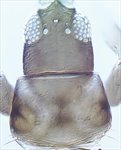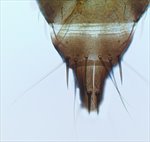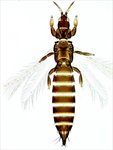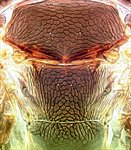
angulicornis head & pronotum

angulicornis antenna

angulicornis tergites VIII-X

denticornis antenna

denticornis female

denticornis meso & metanota
Generic diagnosis
Female macropterous. Head longer than wide, prolonged in front of eyes; maxillary palps 2-segmented; eyes with 6 pigmented facets; ocellar setae I present, setae III lateral to fore ocellus; four pairs of postocular setae not in a straight line. Antennae 8-segmented, segment I without paired dorso-apical setae, II or III often prolonged laterally, III–IV with sense cones either forked or simple, III–VI almost without microtrichia. Pronotum wider than long, one pair of long posteroangular setae. Mesonotum with median pair of setae situated far from posterior margin; anteromedian campaniform sensilla present. Metanotum longitudinally reticulate; median pair of setae far from anterior margin; campaniform sensilla present. Fore wings slender, microtrichial cover sparse, first vein with long gap in setal row, usually seven basal and three distal setae, second vein with eight or nine setae irregularly spaced, posterior fringe cilia wavy; clavus with five veinal and one discal setae. Prosternal ferna divided; basantra membranous, without setae; prospinasternum broad and transverse. Mesosternum with sternopleural sutures reaching anterior margin; endofurca without spinula. Metasternum with sternopleural suture; endofurca without spinula. Tarsi 1- or 2-segmented. Tergites without ctenidia or craspeda; II–VIII with campaniform sensilla close to posterior margin; tergite VIII with setae S3 to S6 stout, without posteromarginal comb; IX with MD setae small, two pairs of campaniform sensilla present; X with median pair of setae short and spine-like, median split complete. Sternites without craspeda; II–VII with discal setae; III–VII with three pairs of posteromarginal setae, II with two pairs, VII with S1 at or in front of margin.
Male apterous; ocelli absent; tergite IX with median pair of setae and posteroangular setae short, median setae arising from tubercles; sternites III–VII each with or without a small pore plate.
Biological data
Breeding on the leaves of Poaceae with adults often found in the inflorescences, these thrips are sometimes abundant on crops of wheat (Triticum).
Distribution data
This is essentially a Palaearctic genus, but consimilis is possibly widespread from eastern Europe across the Palaearctic Region. One species, cerealium (Haliday), has been introduced widely to temperate areas around the world, and angulicornis and denticornis are also widely introduced.
Nomenclatural data
Thrips (Limothrips) Haliday, 1836: 444. Type species Thrips (Limothrips) cerealium Haliday, 1836, by subsequent designation, Westwood, 1838: 46.
Although eight species are listed in this genus (ThripsWiki, 2018), only three are recorded from China:
angulicornis Jablonowski, 1894: 45.
consimilis Priesner, 1926: 143.
denticornis (Haliday, 1836: 445). (Thrips: Limothrips)
Relationship data
Thripidae sub-family Thripinae: this is a diverse group involving more than 230 genera. Traditionally Limothrips has been considered related to Chirothrips. However, the similarities between them possibly reflect their shared host plants, the Poaceae, rather than indicate a phylogenetic relationship.
References
Hu QL, Zhao KX & Feng JN (2012) A newly recorded species of Limothrips Haliday (Thysanoptera, Thripidae) from China. Acta Zootaxonomica Sinica 37 (3): 668–670.
Mirab-balou, M. 2015. A newly recorded species of the genus Limothrips (Thysanoptera: Thripidae) in China, with a key to Chinese species. Journal of Insect biodiversity and Systematics 1 (1): 55–60.
ThripsWiki (2020). ThripsWiki - providing information on the World's thrips. <http://thrips.info/wiki/Main_Page>